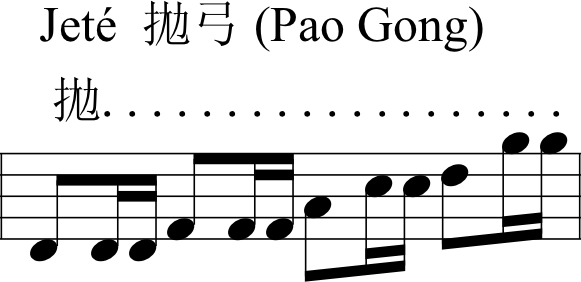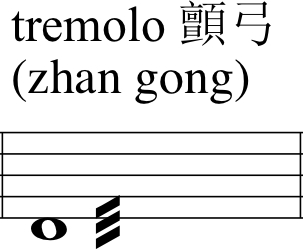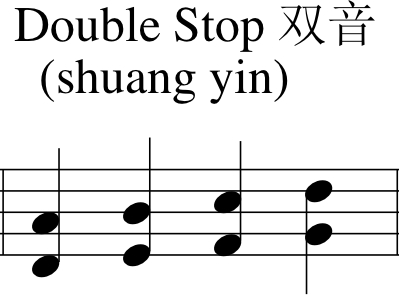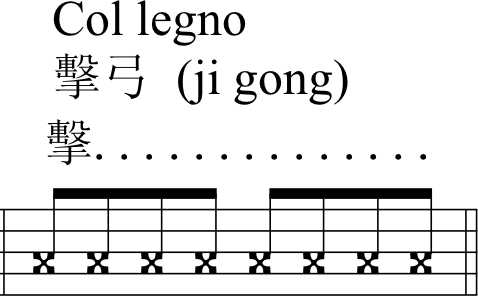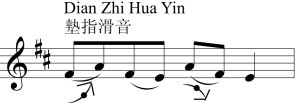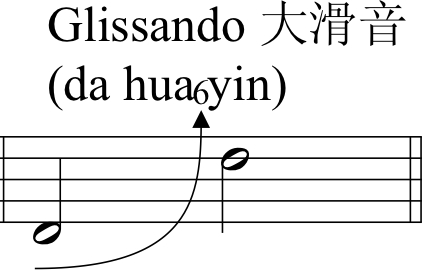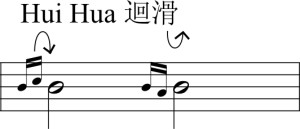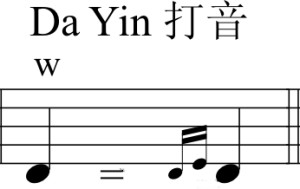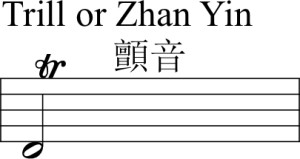This manual is written for composers interested in writing music for the erhu. If you are quoting any of the text or graphics on other web sites, please credit this webpage as the source and Lan Tung as the author, and have a link to this page. thanks
Lan Tung, May 10, 2012 (last update Nov 2015)
Tuning & Range 定弦及音域
 The strings are tuned to D4 (next to the middle C) and A4 (one 5th higher). The D string is called the inside string because it is closer to the player. The A string is called the outside string.
The strings are tuned to D4 (next to the middle C) and A4 (one 5th higher). The D string is called the inside string because it is closer to the player. The A string is called the outside string.
 On the A string, the best tone is produced from the open string (A4) up to about 1.5 octaves, reaching E6. The notes higher than E6 (up to around G6 or A6) are used as well, but it’s harder to control in this register. The volume is much softer in the higher register than the lower register. In general, the bow needs to move a lot faster to produce the tone. The “white noise” of the bow hair and stick robbing against the sound box becomes audible during quieter passages.
On the A string, the best tone is produced from the open string (A4) up to about 1.5 octaves, reaching E6. The notes higher than E6 (up to around G6 or A6) are used as well, but it’s harder to control in this register. The volume is much softer in the higher register than the lower register. In general, the bow needs to move a lot faster to produce the tone. The “white noise” of the bow hair and stick robbing against the sound box becomes audible during quieter passages.
On the D string, it is generally good for one octave. The notes above one octave does not speak well.
Fingering 指法
Composers do not need to write out the fingerings. However, it is good to understand how it works, and to keep in mind how a passage may be played with what kind of fingering because awkward fingering makes it a lot more difficult to play.
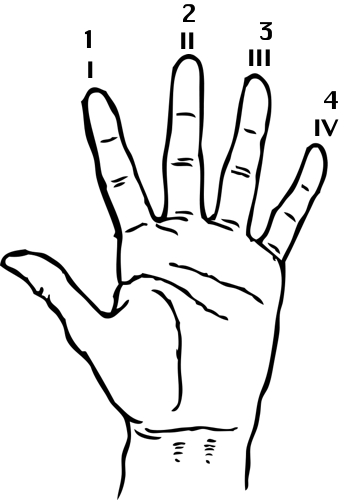 The erhu player uses 4 fingers of the left hand to play the notes, just like the violinist. The fingers are numbered as 1 (forefinger), 2 (middle finger), 3, and 4 (pinky). Always keep in mind that erhu players keep their fingers on both of the strings at the same time. Generally, without changing positions, between the lowest notes on the D string (played by #1 finger) and the highest notes on the A string (played by #4 finger) is an octave. In the higher registers, I can reach more than an octave. But the octave is the basic, and the reference for spacing.
The erhu player uses 4 fingers of the left hand to play the notes, just like the violinist. The fingers are numbered as 1 (forefinger), 2 (middle finger), 3, and 4 (pinky). Always keep in mind that erhu players keep their fingers on both of the strings at the same time. Generally, without changing positions, between the lowest notes on the D string (played by #1 finger) and the highest notes on the A string (played by #4 finger) is an octave. In the higher registers, I can reach more than an octave. But the octave is the basic, and the reference for spacing.
Positions 把位
The erhu has three basic positions:
1) First Position – the first octave from D4 (open string) to E5 (played by #4 finger on the A string).
2) Second Position – from G4 on D string (played by #1 finger) to A5 (played by #4 finger).
3) Third Position – usually only the A string is played, from A5 to D6. The notes on the D strings do not speak well in this octave.
4) Forth Position – only the A string is played, starting from D6, and may go up to G6 or A6. But notes above E6 are rarely used and hard to be in tune. At this position, the notes are very close to each other. The space between a whole tone may be closer than the size of the fingertip. There is not quite enough space on the string to place the fingers to play the scale. It is best to use only a few notes in this register and not play consecutive notes in the scale.
The above positions are based on the fingering of C Major. The notes for each position will be slightly different in different keys which have different fingerings. Generally, #1 finger plays Do (tonic) or Sol (dominant) in each position in each key.
5) Moving Positions – The erhu player can place #1 finger on any pitch to create new positions in between these basic positions. In non-traditional music, this is used more often than the traditional positions.
Playing notes farther apart than an octave requires the change of positions(換把). Depending on the notes, continuous or fast jumping between positions can be difficult or even not playable. Obviously, whenever the open strings are played, it’s easier and gives the player extra time to change between positions.
Tone Colour and Volume 音色與音量
The erhu sounds the best in the first two octaves.  The notes between D4 and G#4 can only be played on the D string. However, A4 and the notes above may be played on either strings. The choice of which string to play is based on the convenience of the fingering, and also the desired tone colours. The notes played on the D string has a softer tone, while the A string notes are brighter. Playing notes of the same phrase on the same string can produce a more unified tone than switching between the strings. Sometimes, the erhu player will choose to play two consecutive A note on different strings to create contrasting colours.
The notes between D4 and G#4 can only be played on the D string. However, A4 and the notes above may be played on either strings. The choice of which string to play is based on the convenience of the fingering, and also the desired tone colours. The notes played on the D string has a softer tone, while the A string notes are brighter. Playing notes of the same phrase on the same string can produce a more unified tone than switching between the strings. Sometimes, the erhu player will choose to play two consecutive A note on different strings to create contrasting colours.
The erhu is not as loud as the violin, but it does have a good range of volume and sound very good in acoustic space without microphones. However, to balance with loud percussion and wind instruments can be difficult. This has to be taken into consideration when composing loud passages in ensembles. In larger ensembles, the erhu may be amplified with a microphone, unless there are multiple erhu to make up a string session.
In general, the erhu player needs to change the bow more often than the violinist to produce the same volume on the same note. This becomes more obvious in higher register, when the erhu becomes much softer. In order to achieve the intensity and volume often required for passages in the higher register, the erhu player needs to bow much faster, and therefore, not able to play as many beats (notes) with one bow.
Keys 調
Theoretically, the erhu can be played in any key because there is no fret. But traditionally erhu music is not written in keys of more than 3 sharps or flats. The open strings, and the 5th and octaves above the open strings, are important reference points for intonation. Keys (such as Ab or Eb) that do not use the open strings in the diatonic scale are more difficult. The fingering is awkward, and the instrument does not resonate as well neither.
Traditional Techniques
1) Right Hand Techniques:
The bow is held with an underhand grip. The bow hair is placed in between the two strings, and both sides of the bow hair are used to produce sound. The player pushes the bow away from the body when bowing the A string (the outside string 外弦), and pulls it inwards when bowing the D string (the inside string 內弦).
Unlike the violin, you can not change the tone colour by playing closer or farther away from the bridge. The erhu bow always sits right on top of the sound box. The player uses the weight of the bow and moves perpendicular to the strings. Lifting the bow above the sound box to play does not produce a clean tone, and is prohibited in traditional techniques.
Most of the following techniques are also used on the violin. The violin terms are mentioned here as references. But most erhu players do not know the Italian terms.
The erhu bow is attached in between the two strings. Therefore, starting a phrase from silence usually is with a down bow (moving from left to right away from the body 拉弓), the opposite of the violin. This technique is indicated by a symbol resembling a small bracket over the note. To play a long sustained note, an up bow (moving from right to left toward the body 推弓) is easier, especially if crescendo is required. These are the idiomatic erhu bowing techniques, but not the only possibilities. In practice, there are many other factors to decide the bowing.
Lian Gong vs Fen Gong 連弓與分弓
Playing more than one note with one bow is called Lian Gong. It is used to play lyrical phrases. Depending on the tempo and dynamic of the music, many notes can be played with one bow on the erhu. The more notes to play with one bow, the softer the overall volume. Fen Gong is to play the notes with more than one bow. Fen Gong is used to break the notes into different phrases or allow faster bow speed for greater dynamics. However, notes played with Fen Gong can also sound lyrical and connected.
Most erhu players prefer to write his/her own bowing to decide where to use lian gong, fen gong, up bow, and down bow. The composer only needs to mark the general phrasings of the music.
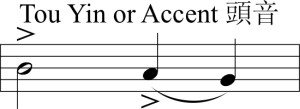 Tou Yin or Accent 頭音
Tou Yin or Accent 頭音
A fast and sudden start of the bow with moderate pressure creates an accent in the beginning of the note. If there are more than one note played with one bow, the accent is usually only played on the first note. To accent the second note in a bow requires a slight stop of the bow (break the tone) before playing the accented note, and it does not have the same crisp tone as accenting the first note.
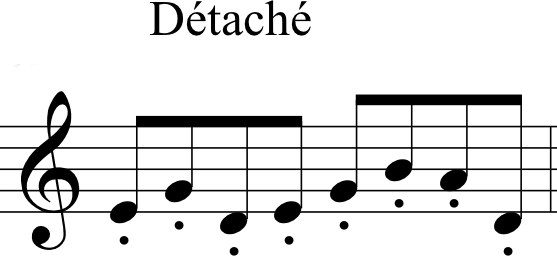 Détaché or staccato or Dun Gong 頓弓
Détaché or staccato or Dun Gong 頓弓
Détaché on the erhu is not as clean as the violin because the bow is always in the middle of the two strings, but it is still used very often.
Lian Dun Gong 連頓弓
This refers to continuous détaché over a number of notes played by one bow. When the bow reaches certain speed, it bounces naturally to continue the motion. It is more successful if the notes are mostly on the same string.
Also known as “ricochet” bowing, this consists of two actions: 1) “throw” the bow on the string with the upper third of the bow to play the 1st 8th note; 2) let the bow bounces back and produces two rapid 16th notes. This is usually used to depict horses galloping. The 8th note can start as a down bow or up bow, but starting with a down bow is more common.
This consists of moving the bow back and forth in very short strokes extremely rapidly, not in measured rhythm.
The only way to play both strings at the same time is to use the bow stick to play the A string and the bow hair to play the D string. Therefore, the tone of the A string is very rough, and the only interval can be played is the 5th. Double stops on the erhu is often aggressive and played in louder passages as a special effect, rather than melodic or harmonic phrases. Switching between single string to double stops can be done instantly. However, it is not as smooth in the higher register since the notes higher than D5 on the D string do not sound very good.
Knocking the bow stick on the sound box. This is to create percussive sound.
Da Ji Gong 大擊弓
Da Ji Gong creates percussive sound resembling horse galloping. There is no specific pitch. It may be notated as a series of 8th notes or 16th notes, depending on the tempo of the music. The bow needs to move in a certain speed to create a natural bouncing motion in order to play Da Ji Gong.
2) Left Hand Techniques:
Vibrato or Rou Xian 揉弦
By waving the fingers up and down, it changes slightly the length of the string, and therefore the pitches. The erhu player often varies the speed of the vibrato on each note, and will also play some notes without vibrato. Unless extreme fast or slow or no vibrato is required, composers do not need to specify where to play vibrato.
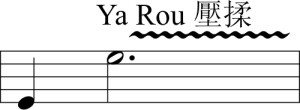 Vibrato while Pressing or Ya Rou 壓弦
Vibrato while Pressing or Ya Rou 壓弦
The other way to vary the pitch is by changing the pressure of the strings. Without the fingerboard, the erhu player can press hard on the strings to raise the pitch slightly. It is the most expressive quality of the erhu. The erhu player will vary the pressure on the string to change the tone colour.
Most of the time, the erhu player uses a combination of different degree of vibrato and pressing on the strings as required by the regional style of the music or personal taste. It may not be notated in the score, but composers can specify it if desired.
The erhu player often decides where to slide between different notes. It happens most often between minor 3rd and when changing different positions, but it can be played between any intervals. It is most often played between notes of the same string and played in one bow. The erhu player also vary the speed of the slides in different phrases. Sometimes lingering longer in the beginning or end of a slide. If the composer wants to have slides or prefer to have no slide at certain notes, please specify. Otherwise, it is common to leave it to the performer as his/her interpretation of the music. In traditional music, slides are used according to the regional style of the music. Too much or too little slides may both be considered “bad taste”.
“Dian Zhi Hua Yin” literally means slide with an extra finger as the medium. It is usually a slide from finger #2 to #4 or vice versa. In the process, roll finger #3 on the string and push slowly to finger #2 or #4. This is often used in southern Chinese music.
Slide over bigger intervals in various speed is a more dramatic expression in erhu music. It can also be combined with tremolo. The composer can choose to specify the starting and ending pitches of the glissando or leave it to the player to decide.
This is a fast slide to a tone higher or lower than the main note and then return right away to the main note.
Notated “w” above the note. Play the main note, followed by the note above the main note, and then return to the main note. The whole sequence happens very quickly, like grace notes.
Notated as “tr” above the note, and often in longer duration. Moving a finger up and down on the string continuously produces a trill. If an interval is not specified, a trill usually involves a tone higher than the main note in the diatonic scale of the piece. However, trill can be played between two notes of any interval as long as they can be played in the same position (within a 4th or 5th) or between any note and the open string. In this case, the composer can write the desired note to be trilled in brackets above the main note. The two notes must be on the same string.
Harmonics of Fan Yin 泛音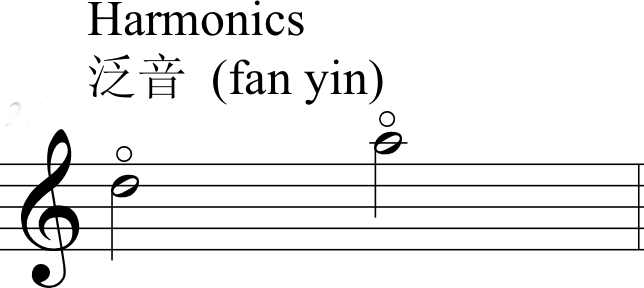
1) Natural harmonics are produced by lightly touching (but not depressing) the string with the finger at certain places, and then bowing the string.. The most often used ones 1/2, 1/3, 1/4 of the strings. For example, the halfway point of the string will produce a harmonic that is one octave above the unfingered (open) string. The natural harmonics on the A string: #C, A, E; on the D string: #F, D, A. In slower tempo traditional music, the erhu player very often plays A5 as a harmonic when sliding into it to change the tone colour.
2) Artificial (touch fourth) harmonics: depresses the string fully with first finger while touching the same string lightly with the fourth finger. This produces a sound two octaves above the stopped note by the first finger.
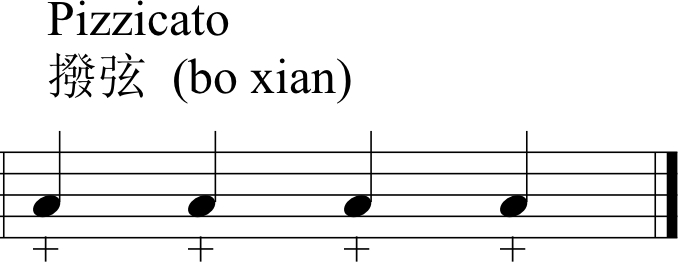 Pizzicato or Bo Xian 撥弦
Pizzicato or Bo Xian 撥弦
The erhu pizzicato is a lot more limited than the violin because the bow is always in the middle of the two strings. The bow will always need to touch one of the strings, leaving only the other string to resonate when it is plucked.
1) A string pizzicato
This is plucked with the left hand (pull off or left hand pizzicato). The first finger presses on the strings to fret the note, while the third finger pulls the A string. The pitch of the plucked note is where the first finger is. This is used to pluck only a single note at a time, and it can be any note on the A string. The sound is very dry, especially in the higher registers.
However, the open string can be easily plucked by any of the first three fingers any time and resonates more. Although not used very often, by alternating rapidly between the first three fingers, it can create a rolling effect on the open note of the A string.
2) D string pizzicato
There are two movements involved: 1) put down the bow on the lap and keep it touching the A string. 2) pluck the string with the right hand.
Most erhu pizzicato are done this way. The sound is dark, but you can play some fast passages. The range is limited to about one octave from the open string. At the end of the plucked phrase, it takes a moment to pick up the bow again to play.
3) Pluck and play at the same time
You can pluck the A string with the left hand and play the D string with the bow at the same time. The only interval can be played is the 5th. This technique works best to play the open strings. However, it is possible to press any note with the first finger and pluck the A string with the 3rd finger, while bowing the D string. The pitches for both strings are where the first finger is. The higher the pitch, the more difficult it is to do. I cannot play fast consecutive notes in this manner, unless it is to repeat the same note.
3) Special Techniques:
Horse Nay 馬嘶
The horse nay consists of two actions: 1) a down bow fast glissando to very hight pitch on the D string ; 2) an up bow slower glissando from the first note moving lower, played with a “lian dun gong”. Horse nay is a special effect without specific pitch. It can be played within a specific number of beats or out of town. However, the down bow and up bow movements are not notated into specific rhythms. The bowing speed is irregular. There is no standard symbol to notate horse hay. Composers want to use it can simply write “horse nay” in an empty measure.
Double Stop Tremolo 雙音顫弓
Combine double stop and tremolo together creates more dramatic sound effect. This can also add glissando.
 Rolling Fingers
Rolling Fingers
This is a special technique used in “Birds Singing in the Mountains” (1928). The erhu player plays the same note 3 times rapidly in one bow changing fingers from #3 to #2, and then #1, creating short slides in between each finger. There is no official name of this technique, which has not been used in other compositions.
Extended techniques (no standard notation symbols and may not be known to all erhu players)
Textures and effects created with unusual bowing techniques
To produce the best tone on the erhu, it requires the balance between the bow pressure and speed, and moving in straight angel. However, an erhu player can deliberately create an imbalance by pressing the bow very hard or moving the bow in the “wrong” angles to create different textures.
1) Scratch Tone – Bowing with high pressure on the strings
A scratch tone is produced by bowing the instrument in normal playing position, but applying very hard pressure to the bow. This produces a grating sound, which can be played with either short bowing (rhythmic/percussive sounds) or long sustained tones. By changing the speed of the bow movement, it can be played with different volumes. Moving the bow in extremely slow motion can produce quiet but very intense long scratchy tones.
2) Bowing with the bow lifted above the sound box
Unlike the violin, the erhu bow usually stays right on the sound box because it is important to relax the bowing hand and use the gravity to play the bow to produce the best tone. Lifting the bow up produces weaker tone, which beginner players often do this. However, when used intentionally, it can be a special effect.
3) Airy sound
Bowing very lightly. The bow hair barely touches the string to produce very airy/breathy sound.
Extended techniques without the bow
Unlike the western string instruments, knocking on the wood surface of the erhu does not produce much sound. The sound box is made of thick and heavy wood with high density. The neck/stick of the erhu is made of a solid piece of wood, which does not resonate.
1) Robbing or tapping the skin
Robbing or tapping gently on the snake skin of the sound box can produce some percussive sound. However, the sound is soft. It is more effective with amplification.
2) vocalize (need to consult the erhu player first. Most players do not sing on stage)
The erhu tone resembles very much human voice. The erhu and voice can blend very well. However, the erhu player will need to tune both the sung note of the voice and the played note on the erhu at the same time. Singing and playing different intervals will not be easily in tune. Depending on the vocal range of the player, the player can sing the same pitch or an octave from the erhu simultaneously.
If holding a long tone on the erhu, then it is possible for the erhu player to sing a different pitch or an answering phrase. Or the erhu player can play a passage while singing a lone tone at the same time.
There is no standard notation for the vocal line for the erhu player. Composers can come up with their own way to notate this. But it is best to avoid using 2 staves. Simply write “sing the same notes or an octave higher/lower” is much easier to read..



